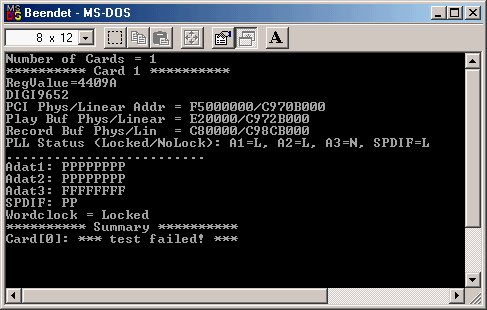 |

Hammerfall Test Software: Hardware Check
»Technical Information
Index

Testing such a versatile hardware as the RME Hammerfall
series requires several expensive test and measurement systems. But there's
an inexpensive and simple to use alternative: Hammerfall
Test performs a fast and complete selftest of all Hammerfalls and their
interfaces found in the current system. And it can be used without special
knowledge or specialized hardware.
Here's how it works:
- The card(s) must be installed under Windows 98/SE/ME
using the latest drivers
- Make a loop connection amongst all I/O ports: ADAT1
in to ADAT1 out, ADAT2 in to ADAT2 out, SPDIF in to SPDIF out. The 9652
adds word clock in to word clock out, plus ADAT3 in to ADAT3 out
- Start the program
The program runs in a DOS window and displays several messages.
These are:
-
Number of found cards
-
Test start, card number
-
Type of card (9652 or 9636)
-
PLL Status: A1 = ADAT1,
N = No Lock, L = Lock etc. The picture to the right shows ADAT3 not locked,
as no cable was connected.
-
Access and memory test:
Sends a 24bit test signal to ADAT Out and analyzes it at ADAT In. With
this all possible error sources, from PC to the Hammerfall's SRAM, are
tested. All channels of each port are tested on their own. Thus the display
will show 8 P (Pass) or F (Failed) for ADAT1 to 3. The screenshot shows
ADAT3 failed, as the cable wasn't connected.
-
Summary: Pass (no error)
or Failed (error.)

The ZIP archive includes two versions of the program:
- w5236_test.exe tests the Windows version of the Hammerfall
- m5236_test.exe tests the Mac version of the Hammerfall
(this too is Windows software!)

Copyright © Matthias Carstens, 2000.
All entries in this Tech Infopaper have been thoroughly checked, however
no guarantee for correctness can be given. RME cannot be held responsible
for any misleading or incorrect information provided throughout this manual.
Lending or copying any part or the complete document or its contents is
only possible with the written permission from RME.
|


